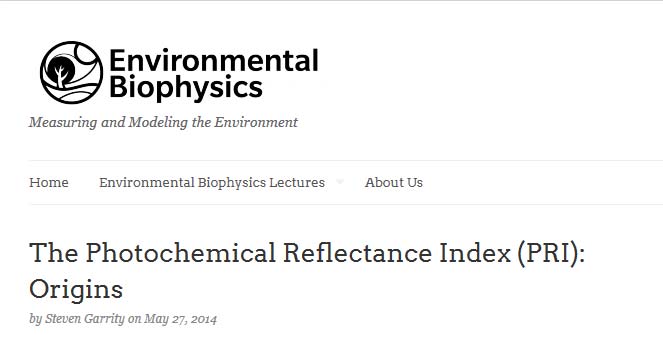
I recently sat down with Dr. John Gamon to discuss his pioneering work with the Photochemical Reflectance Index (PRI). The discussion end up being wide ranging, so we decided to divide the content into a few different posts. What follows is the first installment, focusing on our discussion about the origins of PRI.
PRI Origins
In the early 1990s, John Gamon did a post doc with Dr. Chris Field at Stanford’s Carnegie Institution. His assigned research focus was remote sensing of plant physiology. “I asked Field in an interview, ‘What do you mean by remote sensing of plant physiology?'” Dr. Gamon recalls. “He said he didn’t know. He said it was my job to find out.”
Others at Carnegie, including Wolfgang Bilger and Enrico Brugnoli, were using optical techniques to look at leaf phenomena in the lab. Simultaneously, research on the xanthophyll cycle was finally explaining in more detail how plants cope with excess light during periods of stress. Gamon decided to look for evidence of the xanthophyll cycle using remote sensing techniques.

PRI Pioneer, Dr. John Gamon
Looking for the Xanthophyll Cycle
“In the first experiments where we put the canopy under light stress, we were definitely looking for the xanthophyll cycle,” Gamon says. “Of course, at that time Barbara Demmig-Adams had published some key papers showing that this cycle was tied to excess light, and there was a whole set of phenomenology that had been observed in the laboratory at the leaf scale.”
“It occurred to me that since xanthophylls are pigments, we should be able to see them. Even if our eyes can’t see them, an instrument, if it’s good enough, should be able to detect them. So we designed an experiment to look at the plant canopy under light stress and looked to see if we could see evidence of pigment conversion.
“And we saw it. It was very clear. It was one of those moments that blew my mind, because this is something our eyes can’t see. It’s invisible. But an instrument can see it, and with remote sensing, we saw it.”
Transmitted vs. Reflected Light
Previous optical techniques had focused on transmitted light. Absorbance changes were measured in the lab under “very controlled conditions.” Gamon saw that these techniques made the problem harder than it needed to be. He wanted a better solution.
Since non-absorbed light is both transmitted through the leaf and reflected from it, Gamon postulated that it should be equally possible to observe these different absorption patterns as a reflectance signal. This reflectance signal is what led to the photochemical reflectance index, or PRI.
“We did a lot of experiments relating PRI to plant photosynthesis…, and we found that you could tell a lot about light use efficiency and photosynthetic activity using the xanthophyll cycle signal expressed in PRI,” Gamon says.
Scaling up
He also notes that the PRI offers a further benefit: “If there are subtle changes in pigments that have different absorption patterns…, not only should we be able to see it under laboratory conditions, we should see that cycle operating in nature by looking down at a plant canopy.
“And indeed we can. That’s what we found.”
Scaling up from the leaf level was a logical next step, but it posed many difficult challenges. Looking for the xanthophyll signal on the canopy and landscape scale is “akin to looking for a needle in a haystack,” Gamon says.
We Don’t Fully Understand It, Yet.
Despite the challenges posed by the ‘haystack’ Gamon thinks PRI will be helpful in understanding pigment pools. “The function of the carotenoids over seasons is a very strong indicator of plant health and plant stress, and indirectly of photosynthetic rate, particulary in evergreen plants.
“What we’re learning is that carotenoid metabolism is very central to a lot of what plants do, and PRI is tied to that. I don’t think we fully understand all these connections yet,” Gamon says. “But we will.”
